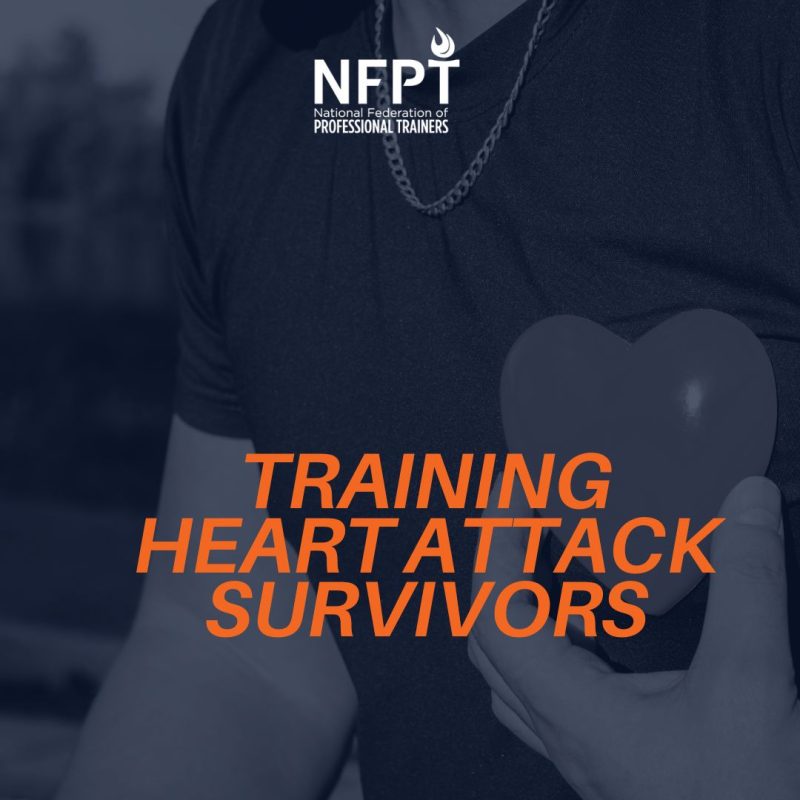
With heart disease being the number one cause of death in the US, it is quite possible that a fitness coach will find him/herself working with a heart attack survivor. It’s a well-known fact that exercise benefits the cardiovascular system. However, once someone has suffered a Myocardial Infarction, the medical term for a heart attack, there are certain things certified personal trainers must consider when training heart attack survivors.
What is a Heart Attack?
Myocardial infarction (MI) is caused by either a decreased or complete cessation of blood flow to a portion of the myocardium–the muscular tissue of the heart.
MIs can be “silent” and go undetected. They can also be a catastrophic event, leading to permanent damage and/or eventual death. Some heart attacks can lead to sudden death.
Five types of MI Classification based on etiology and situation:
Type 1: Spontaneous MI caused by ischemia due to a primary coronary event (e.g., plaque rupture, erosion, or fissuring; coronary dissection)
Type 2: Ischemia due to increased oxygen demand (e.g., hypertension), or decreased supply (e.g., coronary artery spasm or embolism, arrhythmia, hypotension)
Type 3: Related to sudden unexpected cardiac death
Type 4a: Associated with percutaneous coronary intervention (signs and symptoms of myocardial infarction with cTn values > 5 × 99th percentile URL —a measure of mycardial tissue damage)
Type 4b: Associated with documented stent thrombosis
Type 5: Associated with coronary artery bypass grafting (signs and symptoms of myocardial infarction with cTn values > 10 × 99th percentile URL)

from: https://heart.bmj.com/content/103/1/10
Given the range of possible scenarios associated with MIs, it’s important for personal trainers working with heart attack survivors to utilize a Pre-participation Health-Screening Tool and the Par-Q to find the best starting point for the client’s exercise programming and selection.
It’s also best practice to get a Release of Information (ROI) for your client’s doctor and emergency contact.
Common Symptoms of Myocardial Infarction
The following are the most common symptoms of a heart attack:
1) Shortness of breath
2) Chest discomfort or pain
3) Pain or discomfort in the neck, jaw, arm, back, or shoulder
4) Feelings of nausea
5) Fatigue
6) Light-headedness
Exercise Programming and Selection for Heart Attack Survivors
Cardiac rehabilitation typically starts while the affected individual is still in the hospital and is usually administered by staff Exercise Physiologists. Other providers will discuss medications and lifestyle changes with the individual, taking a 360 approach to treatment.
The types of exercises Exercise Physiologists start for heart attack survivors include mild walking and light strength training (usually machines for safety). Some Exercise Physiologists will provide a home program for the survivor. This could include attending aqua aerobics classes or specialty classes for heart attack survivors.
After a heart attack, survivors can start with walking 5-10 minutes a day and build up slowly to 30 minutes over several weeks. The recommendation is to walk at a moderate pace for about 10 minutes the first time and each day try to add one or two minutes. By the end of a month, aim for walking 30 minutes most days of the week. The goal in the initial stages is to build or regain muscular and cardiovascular endurance.
Remember to do a cool-down at the end of your routine by gradually walking slowly for the last 3 minutes.
What’s an Optimal Format to Train Heart Attack Survivors?
Group cardiac rehab exercise sessions should include about 10-12 weeks of structured exercise sessions tailored to each person’s individual needs. This allows them to safely return to fitness, building strength and confidence. However, 10-12 consecutive weeks don’t always occur for a myriad of reasons, such as time and financial resources.
Additionally, sometimes the survivor receives immediate treatment at a hospital in a state or area different from where they live (maybe they were taken to a cardiac specialist hospital) and now they need to return to their hometown. The Exercise Physiologist will then start the sessions and provide instructions for a home program or a referral to a fitness coach in the community to continue the program.
Ideas for a Session
Sessions include a warm-up, the main exercise component, and a cool-down. The main exercise component should include circuit-based training using equipment like stationary bikes, elliptical machines, and machines for strength training.
The warm-up allows the client’s heart to get prepared for exercise with the goal of slightly increasing the heart rate. The client should be only slightly breathless and warm, preparing the body and muscles for work and thereby reducing injury risk.
The Rate of Perceived Exertion (RPE) scale is used during the main exercise component to ensure the client is working at an appropriate intensity that benefits the heart. At an optimal degree of exertion, the client should still be able to hold a conversation (the correlate may range between 8 and 12 on the Borg scale). Some Exercise Physiologists will also check pulse to ensure target heart rate is being reached. However, the RPE is extremely beneficial for home exercise and for the client to track it.
The cool-down gradually brings the heart rate down and back to the clients Resting Heart Rate (RHR).
Why is RPE Important for Training Heart Attack Survivors?
It’s okay if your client is a little short of breath while training, but not so breathless they can’t talk. Watch out for the following warning signs and seek medical advice or assistance if they are noted:
- Chest tightness
- palpitations
- shortness of breath (SOB)
- dizziness.
The Mind-Body Perspective
Heart attack survivors are often allowed to pick which machines they will use during exercise. For example, getting to choose between a bike or elliptical for the warm-up will empower the client to feel more in control of their health and body, and ulimately may help with motivation.
Where Do Personal Trainers Fit in Post-Heart Attack?
Exercise Physiologists will provide the survivor instructions to keep up with a home program. However, some will need coaching and guidance to stay motivated and design exercise variations. Most of cardiac rehab includes walking, and circuit-type training with machines.
The personal trainer can continue to progress the survivor using the same format described above. The key is to continue to use RPE and keep the client in aerobic heart rate zones and keeping an eye out for the common warning signs listed. Fit pros can also progress the clients from machines to more functional exercises, changing the goal from muscular endurance to muscular strength.
Historically, this type of training was discouraged with heart attack survivors because of what’s called the haemodynamic response that happens during isometric (static) exercise. But, weightlifting has been shown not to be purely isometric and has a different haemodynamic response, despite clients having had a heart attack.The haemodynamic response is when there is rapid delivery of blood to active neuronal tissue. This creates complications with individuals who have coronary syndromes.
Ultimately, studies on heart attack survivors have shown that weightlifting is safe and beneficial to heart attack patients’ improvement of functional capacity.
Proper gauging and assessment of the heart attack survivor’s progress will dictate when to alter their program. Personal trainers can take the client from muscular endurance to muscular strength and continue working with the client once released from treatment.
Likely, the client will continue to be monitored by a cardiologist and perhaps be prescribed medications for the long-term. Stay in communication with the client about doctor’s visits and any changes to their medical status in the course of your training relationship.
References
https://pubmed.ncbi.nlm.nih.gov/2291031/
https://my.clevelandclinic.org/departments/heart/patient-education/recovery-care/interventional-procedures/exercise-activity#:~:text=Walk%20at%20a%20moderate%20pace,3%20minute%20of%20your%20exercise
https://www.bhf.org.uk/informationsupport/support/practical-support/cardiac-rehabilitation






